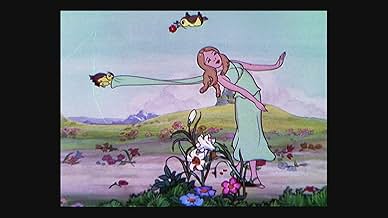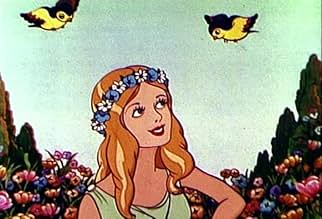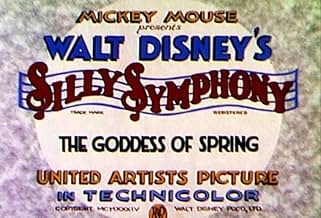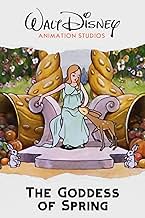VALUTAZIONE IMDb
6,6/10
1542
LA TUA VALUTAZIONE
Aggiungi una trama nella tua linguaThe lovely goddess of spring, Persephone, is kidnapped by Hades, thus bringing about the winter season.The lovely goddess of spring, Persephone, is kidnapped by Hades, thus bringing about the winter season.The lovely goddess of spring, Persephone, is kidnapped by Hades, thus bringing about the winter season.
- Regia
- Sceneggiatura
- Star
Kenny Baker
- Singing Narrator
- (voce)
- (non citato nei titoli originali)
Jessica Dragonette
- Goddess of Spring
- (voce)
- (non citato nei titoli originali)
Tudor Williams
- Pluto
- (voce)
- (non citato nei titoli originali)
Recensioni in evidenza
This entry in the Silly Symphonies adapts the story of Persephone (Proserpina in Latin). "The Goddess of Spring" depicts the title character in an idealistic setting until Hades (Pluto in Latin) kidnaps her. Since she can't be happy in Hell, they have to reach a settlement.
Obviously this is a loose adaptation. As in Disney's "Hercules", Hades gets depicted as a rendering of Satan; in Greek mythology, the underworld had no relation to the modern understanding of Hell.
It's an okay cartoon. I've always been more partial to Warner Bros.'s cartoons, since they had an irreverent side (in contrast to Disney's "nice" cartoons). Jessica Dragonette (the goddess) also voiced Princess Glory in Fleischer Studios' "Gulliver's Travels". Kenny Baker (the narrator) is not to be confused with the actor who played R2D2.
Obviously this is a loose adaptation. As in Disney's "Hercules", Hades gets depicted as a rendering of Satan; in Greek mythology, the underworld had no relation to the modern understanding of Hell.
It's an okay cartoon. I've always been more partial to Warner Bros.'s cartoons, since they had an irreverent side (in contrast to Disney's "nice" cartoons). Jessica Dragonette (the goddess) also voiced Princess Glory in Fleischer Studios' "Gulliver's Travels". Kenny Baker (the narrator) is not to be confused with the actor who played R2D2.
PiThis is obviously the story of Hades and Persephone. As the beauty of summer gives way to winter, she is forced to live underground in a sort of hell. There's more to the story, but suffice it to say that this was an explanation for the change of seasons. Spring is a beautiful young woman and Hades is the stereotypical devil (not really the Greek entity). His operatic voice is stunning and his pleasing must be fore eternity. She is always going tor return.
There may be no better example of emergence of cinematic genius than to watch this and then see "Snow White."
This is a study in human modelling, in the context of dwarfs and nature. Its after the style of the Betty Boop work that controlled expectations on the animated screen with a little bit more grace. But it still features thin figures with cartoon movements rather than human ones. It was done as a test for Snow White.
Almost nothing here was used in that later project and its a good thing. There is nothing attractive about it at all.
But I can still see a serious attempt at finding that vocabulary of movements that seems human but isn't, looks natural and warm but is abstract and seems to capture a version of womanhood without referencing sex. Its only hinted here and perfected in a way later. I'm not at all sure if we can know whether in Snow White Walt and company touched something we knew, or whether he created something that we grew into with our ideals and imagination. I believe it is the latter, which makes this experiment more interesting.
Suppose he would have stuck with what he had here. Would we have grown around it and adapted a wholly different vision of innocent perfection?
Ted's Evaluation -- 2 of 3: Has some interesting elements.
This is a study in human modelling, in the context of dwarfs and nature. Its after the style of the Betty Boop work that controlled expectations on the animated screen with a little bit more grace. But it still features thin figures with cartoon movements rather than human ones. It was done as a test for Snow White.
Almost nothing here was used in that later project and its a good thing. There is nothing attractive about it at all.
But I can still see a serious attempt at finding that vocabulary of movements that seems human but isn't, looks natural and warm but is abstract and seems to capture a version of womanhood without referencing sex. Its only hinted here and perfected in a way later. I'm not at all sure if we can know whether in Snow White Walt and company touched something we knew, or whether he created something that we grew into with our ideals and imagination. I believe it is the latter, which makes this experiment more interesting.
Suppose he would have stuck with what he had here. Would we have grown around it and adapted a wholly different vision of innocent perfection?
Ted's Evaluation -- 2 of 3: Has some interesting elements.
A Walt Disney SILLY SYMPHONY Cartoon Short.
Persephone, THE GODDESS OF SPRING, is kidnapped by Hades, the devilish god of the Underworld, leaving the earth in perpetual winter. Will the warmth & joy of Spring ever return?
A vivid, and somewhat bizarre, little film which retells the story from Greek Mythology, while incorporating both operatic & jazz traditions. The animators seem to have confused the character of Hades with that of the Biblical Satan. Years later, Walt would draw comparison between Persephone & Snow White, to illustrate how far his animators evolved in just three short years.
The SILLY SYMPHONIES, which Walt Disney produced for a ten year period beginning in 1929, are among the most fascinating of all animated series. Unlike the Mickey Mouse cartoons in which action was paramount, with the Symphonies the action was made to fit the music. There was little plot in the early Symphonies, which featured lively inanimate objects and anthropomorphic plants & animals, all moving frantically to the soundtrack. Gradually, however, the Symphonies became the school where Walt's animators learned to work with color and began to experiment with plot, characterization & photographic special effects. The pages of Fable & Fairy Tale, Myth & Mother Goose were all mined to provide story lines and even Hollywood's musicals & celebrities were effectively spoofed. It was from this rich soil that Disney's feature-length animation was to spring. In 1939, with SNOW WHITE successfully behind him and PINOCCHIO & FANTASIA on the near horizon, Walt phased out the SILLY SYMPHONIES; they had run their course & served their purpose.
Persephone, THE GODDESS OF SPRING, is kidnapped by Hades, the devilish god of the Underworld, leaving the earth in perpetual winter. Will the warmth & joy of Spring ever return?
A vivid, and somewhat bizarre, little film which retells the story from Greek Mythology, while incorporating both operatic & jazz traditions. The animators seem to have confused the character of Hades with that of the Biblical Satan. Years later, Walt would draw comparison between Persephone & Snow White, to illustrate how far his animators evolved in just three short years.
The SILLY SYMPHONIES, which Walt Disney produced for a ten year period beginning in 1929, are among the most fascinating of all animated series. Unlike the Mickey Mouse cartoons in which action was paramount, with the Symphonies the action was made to fit the music. There was little plot in the early Symphonies, which featured lively inanimate objects and anthropomorphic plants & animals, all moving frantically to the soundtrack. Gradually, however, the Symphonies became the school where Walt's animators learned to work with color and began to experiment with plot, characterization & photographic special effects. The pages of Fable & Fairy Tale, Myth & Mother Goose were all mined to provide story lines and even Hollywood's musicals & celebrities were effectively spoofed. It was from this rich soil that Disney's feature-length animation was to spring. In 1939, with SNOW WHITE successfully behind him and PINOCCHIO & FANTASIA on the near horizon, Walt phased out the SILLY SYMPHONIES; they had run their course & served their purpose.
Iprobably only saw this cartoon ONCE and I was probably under FIVE years old. Talk about making an impression, that would have been forty something years ago and I still remember a lot of it - Persephone picking flowers, Hades coming our oft ground on something like a spinning turn table, little devils dancing around singing "Hidey Hades" (maybe actually Mighty Hades?) , Persephony in tears pointing upwards, and Hades retuning her to the upper world on that turntable thing. It was a segment at the end of the Mickey Mouse Club TV show, they would open a drawer and pull out the title of that day's cartoon. I saw it once and though I wanted to see it again, I never did.
Years later I read Edith Hamilton's Mythology - one of my all time favorite books - and there was the story of Hades and Persephone!
I sure wish this would come out on DVD or something.
Disney would make a fortune with a vintage Disney Channel - run to old Mickey Mouse Series, the Silly Symphony cartoons, those fantastic serials like Spin and Marty, Boys of the Western Sea. I have to confess I have not seen the new cable but I would bet it is junk.
And Anettw Funichello can out Mousketeer Brittany Spears any day!!!!
Years later I read Edith Hamilton's Mythology - one of my all time favorite books - and there was the story of Hades and Persephone!
I sure wish this would come out on DVD or something.
Disney would make a fortune with a vintage Disney Channel - run to old Mickey Mouse Series, the Silly Symphony cartoons, those fantastic serials like Spin and Marty, Boys of the Western Sea. I have to confess I have not seen the new cable but I would bet it is junk.
And Anettw Funichello can out Mousketeer Brittany Spears any day!!!!
Lo sapevi?
- QuizWalt Disney and his animators used this short as a test to see if they could create realistic animation, a style they would later perfect in Biancaneve e i sette nani (1937).
I più visti
Accedi per valutare e creare un elenco di titoli salvati per ottenere consigli personalizzati
Dettagli
- Data di uscita
- Paese di origine
- Sito ufficiale
- Lingua
- Celebre anche come
- A Greek Myth
- Azienda produttrice
- Vedi altri crediti dell’azienda su IMDbPro
- Tempo di esecuzione10 minuti
- Proporzioni
- 1.37 : 1
Contribuisci a questa pagina
Suggerisci una modifica o aggiungi i contenuti mancanti

Divario superiore
By what name was La dea della primavera (1934) officially released in Canada in English?
Rispondi




















